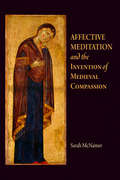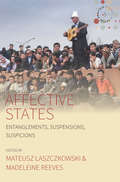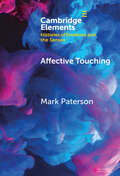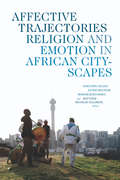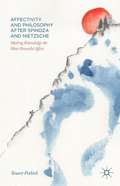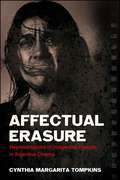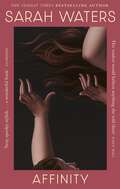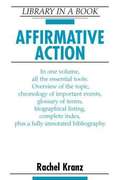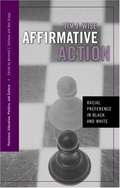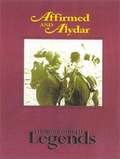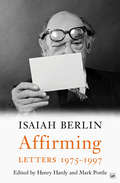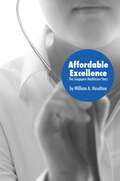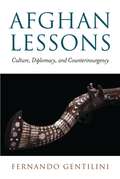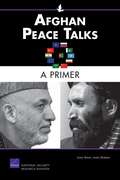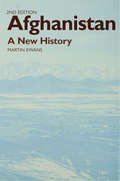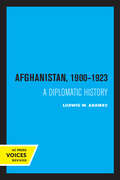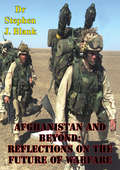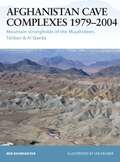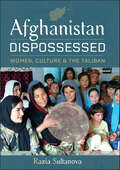- Table View
- List View
Affective Meditation and the Invention of Medieval Compassion (The Middle Ages Series)
by Sarah McNamerAffective meditation on the Passion was one of the most popular literary genres of the high and later Middle Ages. Proliferating in a rich variety of forms, these lyrical, impassioned, script-like texts in Latin and the vernacular had a deceptively simple goal: to teach their readers how to feel. They were thus instrumental in shaping and sustaining the wide-scale shift in medieval Christian sensibility from fear of God to compassion for the suffering Christ.Affective Meditation and the Invention of Medieval Compassion advances a new narrative for this broad cultural change and the meditative writings that both generated and reflected it. Sarah McNamer locates women as agents in the creation of the earliest and most influential texts in the genre, from John of Fécamp's Libellus to the Meditationes Vitae Christi, thus challenging current paradigms that cast the compassionate affective mode as Anselmian or Franciscan in origin. The early development of the genre in women's practices had a powerful and lasting legacy. With special attention to Middle English texts, including Nicholas Love's Mirror and a wide range of Passion lyrics and laments, Affective Meditation and the Invention of Medieval Compassion illuminates how these scripts for the performance of prayer served to construct compassion itself as an intimate and feminine emotion. To feel compassion for Christ, in the private drama of the heart that these texts stage, was to feel like a woman. This was an assumption about emotion that proved historically consequential, McNamer demonstrates, as she traces some of its legal, ethical, and social functions in late medieval England.
Affective States: Entanglements, Suspensions, Suspicions
by Madeleine Reeves Mateusz LaszczkowskiIn recent years, political and social theory has been transformed by the heterogeneous approaches to feeling and emotion jointly referred to as 'affect theory'. These range from psychological and social-constructivist approaches to emotion to feminist and post-human perspectives. Covering a wide spectrum of topics and ethnographic contexts-from engineering in the Andes to household rituals in rural China, from South African land restitution to migrant living in Moscow, and from elections in El Salvador to online and offline surveillance among political refugees from Uzbekistan and Eritrea-the chapters in this volume interrogate this 'affective turn' through the lens of fine-grained ethnographies of the state. The volume enhances the anthropological understanding of the various ways through which the state comes to be experienced as a visceral presence in social life.
Affective Touching: Neurobiology and Technological Applications (Elements in Histories of Emotions and the Senses)
by Mark PatersonAt the end of the twentieth century the discovery of 'slow', affective touch nerves in humans known as C Tactile (CT) afferents, which are entirely separate from the faster pathways for touching objects, had huge social implications. The Swedish neuroscientists responsible formulated an “affective touch hypothesis” or “social touch hypothesis” to consider their purpose. Part I offers a history of the science of social touch, from related discoveries in mammals by physiologists in the 1930s, to the recent rediscoveries of the CT nerves in humans. Part II considers how these findings are being intentionally folded into technologies for interaction. First, as mediated social touch, communicating at a distance through haptics. Second, with the increasing number of social and service robots in health care and domestic settings, the role of affective touch within human-robot interaction design.
Affective Trajectories: Religion and Emotion in African Cityscapes (Religious Cultures of African and African Diaspora People)
by Hansjörg Dilger Marian Burchardt Matthew Wilhelm-Solomon Astrid BochowThe contributors to Affective Trajectories examine the mutual and highly complex entwinements between religion and affect in urban Africa in the early twenty-first century. Drawing on ethnographic research throughout the continent and in African diasporic communities abroad, they trace the myriad ways religious ideas, practices, and materialities interact with affect to configure life in urban spaces. Whether examining the affective force of the built urban environment or how religious practices contribute to new forms of attachment, identification, and place-making, they illustrate the force of affect as it is shaped by temporality and spatiality in the religious lives of individuals and communities. Among other topics, they explore Masowe Apostolic Christianity in relation to experiences of displacement in Harare, Zimbabwe; Muslim identity, belonging, and the global ummah in Ghana; crime, emotions, and conversion to neo-Pentecostalism in Cape Town; and spiritual cleansing in a Congolese branch of a Japanese religious movement. In so doing, the contributors demonstrate how the social and material living conditions of African cities generate diverse affective forms of religious experiences in ways that foster both localized and transnational paths of emotional knowledge.Contributors. Astrid Bochow, Marian Burchardt, Rafael Cazarin, Hansjörg Dilger, Alessandro Gusman, Murtala Ibrahim, Peter Lambertz, Isabelle L. Lange, Isabel Mukonyora, Benedikt Pontzen, Hanspeter Reihling, Matthew Wilhelm-Solomon
Affectivity and Philosophy after Spinoza and Nietzsche: Making Knowledge The Most Powerful Affect
by Stuart PethickPethick investigates a much neglected philosophical connection between two of the most controversial figures in the history of philosophy: Spinoza and Nietzsche. By examining the crucial role that affectivity plays in their philosophies, this book claims that the two philosophers share the common goal of making knowledge the most powerful affect.
Affectual Erasure: Representations of Indigenous Peoples in Argentine Cinema (SUNY series in Latin American Cinema)
by Cynthia Margarita TompkinsAffectual Erasure examines how Argentine cinema has represented Indigenous peoples throughout a period spanning roughly a century. Cynthia Margarita Tompkins interrelates her discussion of films with the ethnographic context of the Indigenous peoples represented and an analysis of the affective dimensions at play. These emotions underscore the inherent violence of generic conventions, as well as the continued political violence preventing Indigenous peoples from access to their ancestral lands and cultural mores. Tompkins explores a broad range of movies beginning in the silent period and includes both feature films and documentaries, underscored by archival and contemporary film stills. She traces the initial erotic projection, moving through melodrama to the conventions of the Western, into the 1960s focus on decolonization, superseded by allegorical renditions and the promise of self-expression in late twentieth-century documentaries. Each section includes an introduction to the sociohistorical events of the period and their impact on film production. Analyzed chronologically, the films evidence different stages in the projection of the hegemonic Argentine imaginary, which fails to envision the daily life of Indigenous peoples prior to conquest or in colonial times—and remains in denial of their existence in the present.
Affinity
by Sarah Waters'Affinity is the work of an intense and atmospheric imagination . . . Sarah Waters is such an interesting writer, a kind of feminist Dickens' Fiona Pitt-Kethley, Daily TelegraphSet in and around the women's prison at Milbank in the 1870s, Affinity is an eerie and utterly compelling ghost story, a complex and intriguing literary mystery and a poignant love story with an unexpected twist in the tale. Following the death of her father, Margaret Prior has decided to pursue some 'good work' with the lady criminals of one of London's most notorious gaols. Surrounded by prisoners, murderers and common thieves, Margaret feels herself drawn to one of the prisons more unlikely inmates - the imprisoned spiritualist - Selina Dawes. Sympathetic to the plight of this innocent-seeming girl, Margaret sees herself dispensing guidance and perhaps friendship on her visits, little expecting to find herself dabbling in a twilight world of seances, shadows, unruly spirits and unseemly passions.
Affinity
by Sarah WatersSet in and around the women's prison at Milbank in the 1870's , AFFINITY is an eerie and utterly compelling ghost story, a complex and intriguing literary mystery and a poignant love story with an unexpected twist in the tale. Following the death of her father, Margaret Prior has decided to pursue some 'good work' with the lady criminals of one of London's most notorious gaols. Surrounded by prisoners, murderers and common thieves, Margaret feels herself drawn to one of the prisons more unlikely inmates - the imprisoned spiritualist - Selina Dawes. Sympathetic to the plight of this innocent-seeming girl, Margaret sees herself dispensing guidance and perhaps friendship on her visits, little expecting to find herself dabbling in a twilight world of seances, shadows, unruly spirits and unseemly passions.
Affirmative Action
by Rachel KranzOne of the most controversial political issues of the past three decades has been the question of affirmative action. The phrase was first used in 1965 when President Lyndon B. Johnson issued Executive Order 11246.
Affirmative Action: Racial Preference in Black and White
by Tim J. WiseAffirmative Action examines the larger structure of institutional white privilege in education, and compares the magnitude of white racial preference with the policies typically envisioned when the term "racial preference" is used. In doing so, the book demonstrates that the American system of education is both a reflection of and a contributor to a structure of institutionalized racism and racial preference for the dominant majority.
Affirmed and Alydar: Racing's Greatest Rivalry (Thoroughbred Legends #15)
by Timothy T. CappsThe greatest rivalry in modern racing history began with little fanfare on June 15, 1977. The more experienced Affirmed defeated Alydar, who was making his racing debut in the Youthful Stakes at Belmont Park. In nine subsequent meetings, Affirmed got the better of Alydar six times, often by just inches. Their meetings, especially during the Triple Crown season of 1978, became the stuff of racing lore. Affirmed claimed the Triple Crown, but Alydar tested him to the limits each time in stirring stretch drives that left onlookers limp. Indeed, many racing historians consider their Belmont Stakes to be the greatest race of the 20th century. To tell one’s story is to tell the other’s, so closely intertwined are the lives of Affirmed and Alydar. Author Tim Capps, who witnessed many of the Affirmed-Alydar races, chronicles their early years, first encounters, and epic clashes. He also tells the stories of the people who raised, trained, and rode these titans. Affirmed was bred in Florida by financier Louis Wolfson, trained by the legendary Laz Barrera, and ridden by Steve Cauthen, known as “The Kid.” Alydar entered life on the historic grounds of Calumet Farm in Lexington, Kentucky, the last great horse of the old Wright regime. Trained by the young John Veitch, Alydar would have been a Triple Crown winner in any other year. As a stallion, Alydar surpassed his nemesis although Affirmed found surprising success as a sire of turf horses.
Affirming: Letters 1975-1997
by Isaiah Berlin‘IB was one of the great affirmers of our time.’ John Banville, New York Review of BooksThe title of this final volume of Isaiah Berlin’s letters is echoed by John Banville’s verdict in his review of its predecessor, Building: Letters 1960–75, which saw Berlin publish some of his most important work, and create, in Oxford’s Wolfson College, an institutional and architectural legacy. In the period covered by this new volume (1975–97) he consolidates his intellectual legacy with a series of essay collections. These generate many requests for clarification from his readers, and stimulate him to reaffirm and sometimes refine his ideas, throwing substantive new light on his thought as he grapples with human issues of enduring importance.Berlin’s comments on world affairs, especially the continuing conflict between Israel and the Palestinians, and the collapse of Communism, are characteristically acute. This is also the era of the Northern Ireland Troubles, the Iranian revolution, the rise of Solidarity in Poland, the Chernobyl nuclear disaster, the fall of the Berlin Wall, Ayatollah Khomeini’s fatwa against Salman Rushdie, the spread of Islamic fundamentalism, and wars in the Falkland Islands, the Persian Gulf and the Balkans. Berlin scrutinises the leading politicians of the day, including Reagan, Thatcher and Gorbachev, and draws illuminating sketches of public figures, notably contrasting the personas of Alexander Solzhenitsyn and Andrey Sakharov. He declines a peerage, is awarded the Agnelli Prize for ethics, campaigns against philistine architecture in London and Jerusalem, helps run the National Gallery and Covent Garden, and talks at length to his biographer. He reflects on the ideas for which he is famous – especially liberty and pluralism – and there is a generous leavening of the conversational brilliance for which he is also renowned, as he corresponds with friends about politics, the academic world, music and musicians, art and artists, and writers and their work, always displaying a Shakespearean fascination with the variety of humankind.Affirming is the crowning achievement both of Berlin’s epistolary life and of the widely acclaimed edition of his letters whose first volume appeared in 2004.
Affordable Excellence: The Singapore Health System
by William A. HaseltineThis is the story of the Singapore healthcare system: how it works, how it is financed, its history, where it is going, and what lessons it may hold for national health systems around the world. Singapore ranks sixth in the world in healthcare outcomes, yet spends proportionally less on healthcare than any other high-income country. This is the first book to set out a comprehensive system-level description of healthcare in Singapore, with a view to understanding what can be learned from its unique system design and development path.The lessons from Singapore will be of interest to those currently planning the future of healthcare in emerging economies, as well as those engaged in the urgent debates on healthcare in the wealthier countries faced with serious long-term challenges in healthcare financing. Policymakers, legislators, public health officials responsible for healthcare systems planning, finance and operations, as well as those working on healthcare issues in universities and think tanks should understand how the Singapore system works to achieve affordable excellence.
Affordable Housing in New York: The People, Places, and Policies That Transformed a City
by Nicholas Dagen Bloom Matthew Gordon LasnerA richly illustrated history of below-market housing in New York, from the 1920s to todayA colorful portrait of the people, places, and policies that have helped make New York City livable, Affordable Housing in New York is a comprehensive, authoritative, and richly illustrated history of the city's public and middle-income housing from the 1920s to today. Plans, models, archival photos, and newly commissioned portraits of buildings and tenants by sociologist and photographer David Schalliol put the efforts of the past century into context, and the book also looks ahead to future prospects for below-market subsidized housing. A dynamic account of an evolving city, Affordable Housing in New York is essential reading for understanding and advancing debates about how to enable future generations to call New York home.
Afgezonderd met mijn Hellion
by Dawn BrowerLady Odessa Lynwood is dol op de graaf van Havenwood sinds ze een jong meisje was. Hij is de beste vriend van haar broer en hun naaste buurman. Ze is het beu dat hij haar ontwijkt en besluit er iets aan te doen. Er is geen twijfel in haar gedachten dat hij ook van haar houdt; ze begrijpt echter niet waarom hij het ontkent. Ze verlaat Kingbridge, haar ouderlijk huis, op de rand van een sneeuwstorm om hem te confronteren. Gavin Barrington, de graaf van Havenwood, heeft geen reden gegeven om zijn voornemen om Odessa voor een zeer goede reden te verklaren. Zijn familie is vervloekt en hij weigert haar te onderwerpen aan de ramp die zijn familienaam haar zou brengen. Maar wanneer ze vastzitten in een jachthut tijdens een epische sneeuwstorm, verandert alles. In het midden van de sneeuwstorm moeten ze hun liefde verwerken en uitzoeken of ze Gavins ergste angsten kunnen overwinnen en samen een leven kunnen leiden.
Afghan Lessons
by Fernando GentiliniFernando Gentilini served nearly two years as the civilian representative of NATO in Afghanistan, running a counterinsurgency campaign in the wartorn nation. Afghan Lessons is the fascinating story of his mission, a firsthand view of Afghanistan through a kaleidoscope. He explores Afghan history, literature, tradition, and culture to understand some of the most basic questions of Western involvement: What is the purpose? What does an international presence mean, and how can it help?Highlights from Afghan Lessons"This is a book about different worlds, different realities. The reality of everyday life in an unreal world. People that need to be looked after, jobs that need to be done, a country that needs to be restored, all from within the necessary confines of an armed camp. And this in the middle of another reality, which we do not understand, full of things forgotten under decades of war. The keys to this reality lie in the past, perhaps lost." -from the Foreword by Robert Cooper"To tempt me to explore their country, the Afghans kept repeating that there were three different Afghanistans: 'The first is the one you Westerners imagine; another coincides with the city of Kabul; the third is the country of remote provinces, far away from the cities, and of the three, this is the only real Afghanistan.'""'There can be no development without security and no security without development.' ... Everyone said it over and over again, both the civilians and the military, but depending on whether it was said by the former or the latter, the emphasis was placed on the first or second part of the slogan. In all honesty this seemingly obvious concept concealed two contrasting ways of seeing things."
Afghan Modern: The History of a Global Nation
by Robert D. Crews<p>Rugged, remote, riven by tribal rivalries and religious violence, Afghanistan seems to many a country frozen in time and forsaken by the world. Afghan Modern presents a bold challenge to these misperceptions, revealing how Afghans, over the course of their history, have engaged and connected with a wider world and come to share in our modern globalized age. <p>Always a mobile people, Afghan travelers, traders, pilgrims, scholars, and artists have ventured abroad for centuries, their cosmopolitan sensibilities providing a compass for navigating a constantly changing world. Robert Crews traces the roots of Afghan globalism to the early modern period, when, as the subjects of sprawling empires, the residents of Kabul, Kandahar, and other urban centers forged linkages with far-flung imperial centers throughout the Middle East and Asia. Focusing on the emergence of an Afghan state out of this imperial milieu, he shows how Afghan nation-making was part of a series of global processes, refuting the usual portrayal of Afghans as pawns in the “Great Game” of European powers and of Afghanistan as a “hermit kingdom.” <p>In the twentieth century, the pace of Afghan interaction with the rest of the world dramatically increased, and many Afghan men and women came to see themselves at the center of ideological struggles that spanned the globe. Through revolution, war, and foreign occupations, Afghanistan became even more enmeshed in the global circulation of modern politics, occupying a pivotal position in the Cold War and the tumultuous decades that followed.</p>
Afghan Peace Talks
by James Dobbins James ShinnThe objective of a negotiated peace in Afghanistan has been firmly embraced by most of the potential parties to a treaty. However, arriving at an agreement about the sequencing, timing, and prioritization of peace terms is likely to be difficult, given the divergence in the parties' interests and objectives. The U.S. objective in these negotiations should be a stable and peaceful Afghanistan that neither hosts nor collaborates with terrorists.
Afghanistan
by Thomas BarfieldAfghanistan traces the historic struggles and the changing nature of political authority in this volatile region of the world, from the Mughal Empire in the sixteenth century to the Taliban resurgence today. Thomas Barfield introduces readers to the bewildering diversity of tribal and ethnic groups in Afghanistan, explaining what unites them as Afghans despite the regional, cultural, and political differences that divide them. He shows how governing these peoples was relatively easy when power was concentrated in a small dynastic elite, but how this delicate political order broke down in the nineteenth and twentieth centuries when Afghanistan's rulers mobilized rural militias to expel first the British and later the Soviets. Armed insurgency proved remarkably successful against the foreign occupiers, but it also undermined the Afghan government's authority and rendered the country ever more difficult to govern as time passed. Barfield vividly describes how Afghanistan's armed factions plunged the country into a civil war, giving rise to clerical rule by the Taliban and Afghanistan's isolation from the world. He examines why the American invasion in the wake of September 11 toppled the Taliban so quickly, and how this easy victory lulled the United States into falsely believing that a viable state could be built just as easily. Afghanistan is essential reading for anyone who wants to understand how a land conquered and ruled by foreign dynasties for more than a thousand years became the "graveyard of empires" for the British and Soviets, and what the United States must do to avoid a similar fate.
Afghanistan - A New History
by Robyn Carr Patrick Weber Martin Ewans Sir Martin EwansSir Martin Ewans, former Head of the British Chancery in Kabul, puts into an historical and contemporary context the series of tragic events that have impinged on Afghanistan in the past fifty years. The book examines the roots of these developments in Afghanistan's earlier history and external relationships, as well as their contemporary relevance
Afghanistan 1900 - 1923: A Diplomatic History
by Ludwig W. AdamecThis title is part of UC Press's Voices Revived program, which commemorates University of California Press’s mission to seek out and cultivate the brightest minds and give them voice, reach, and impact. Drawing on a backlist dating to 1893, Voices Revived makes high-quality, peer-reviewed scholarship accessible once again using print-on-demand technology. This title was originally published in 1967.
Afghanistan And Beyond: Reflections On The Future Of Warfare
by Dr Stephen J. BlankMany military analysts believe or fear that the wars of the 1990s will be akin to the wars in the former Yugoslavia: small-scale but long-lasting and recurrent ethnic wars that also elude easy international resolution. There are consequently well-founded concerns about prospects for deployment of U.S. forces there in a unilateral or U.N. capacity. Some of the lessons of this kind of war were already apparent in the wars of the 1980s. They were known then as low-intensity conflicts and now as operations other than, or short of, war.This report focuses mainly on lessons from one of the most crucial of these wars, i.e., in Afghanistan as a result of the Soviet invasion in 1979, and attempts to draw lessons that are relevant for current wars, like those in Yugoslavia or the ex-Soviet Union. The purpose is to stimulate analysis and reflection on the strategic and operational, if not also tactical nature of these wars by both analysts and policymakers so that all interested groups can more easily come to terms with a form of warfare that promises to be both deeply destructive and deeply rooted in longstanding political and social antagonisms that cannot be easily or quickly resolved.Naturally some of the lessons drawn from Afghanistan and other wars may either only apply to Russian and Soviet forces or conversely may apply to war in general. But our primary intention is to make a contribution to the study of future wars particularly of the ethnic and small-scale type that promise to continue in many parts of the globe lest we devise better ways for averting and then resolving them.
Afghanistan Cave Complexes 1979-2004
by Ian Palmer Mir BahmanyarFollowing the Soviet invasion in 1979, the Mujahideen defenders of Afghanistan developed and reinforced many natural cave systems to use as supply bases and defensive positions. The Taliban and Al Qaeda further strengthened these positions in the 1990s. Following the events of September 11, 2001, these cave systems have once more come to prominence and sites such as Tora Bora and Zhawar Kili have featured in news headlines around the world. This title provides an analysis of these caves and underground systems, and discusses the U.S.-led Coalition's tactical approach to dislodging the enemy from these fortified positions.
Afghanistan Conflict and Australia's Role (Islamic Studies Series)
by Amin SaikalA decade after the US-led invasion of Afghanistan in October 2001, the country continues to face a growing insurgency and crises of governance. The Afghanistan Conflict and Australia's Role tackles a number of critical dimensions-politics, society, military, and reconstruction-of this conflict from a range of perspectives.This book unpacks the nature and complexity of the conflict at national and international levels. It makes a critical assessment of the performance of President Hamid Karzai and his government, and the efforts made by the international community, the US and its NATO and non-NATO allies in particular, to stabilise, rebuild and secure Afghanistan as a viable state. In addition, it examines critically the role played by Australia in the conflict.The conclusions are far-reaching, with relevance to anyone interested in the interconnectedness of many contemporary issues-governance, democratisation, development, the role of the media, and counterinsurgency. Islamic Studies Series - Volume 8
Afghanistan Dispossessed: Women, Culture & the Taliban
by Razia SultanovaA focused history of women and popular culture in Afghanistan from the Soviet invasion, to 9/11, to the Taliban's takeover.How does normal social, cultural, religious life survive in constant turmoil? How can the people flourish? These basic questions are examined and answered by Razia Sultanova's academic analysis and deep fieldwork, with extensive eyewitness and personal contacts and conversations with a wide variety of Afghan men and women. She looks at basic questions of gender, identity, nation, tradition, history, popular culture and especially the role of music - classical, popular, modern and contemporary - as a vital element for survival. And all is over-shadowed by the Taliban with on-going threat of terror and repression especially for women and girls. Here is a classical story of a people's struggle for everyday normality and preservation of cherished traditions in a war-torn society.
